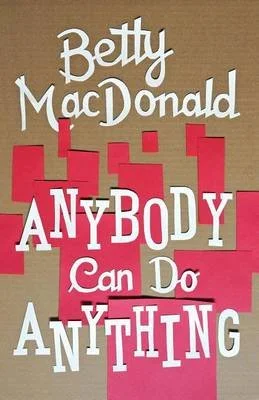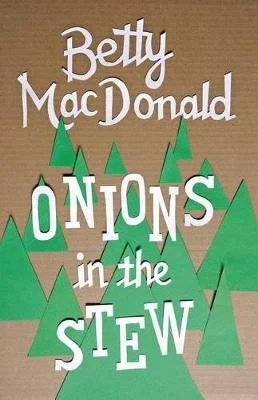
Books by Betty MacDonald
(Please note: I love Betty’s books and warmly recommend all those listed below. I do not earn any commission from sales.)
Jump to:
The Egg and I
Well educated and raised as a lady, young Betty Bard in 1927 married an ex-soldier she barely knew. The newlyweds immediately started a chicken ranch in the remote American Northwest. Here Betty had to contend with a difficult husband, loneliness, pregnancy, primitive neighbors, and thousands of chickens. This was the stuff of her first book and the beginnings of a unique writer: in 1945 she published The Egg and I, a hugely funny, lightly fictionalised account of her life as a chicken farmer.
At first the two are occupied with just getting the previously derelict farm into some kind of shape: building the chicken houses, planting the garden and a back field (with a horse, not machinery), clearing the orchard of stumps, and buying several hundred yeeping baby chicks. Only then does husband Bob allow them to start on the lesser matter of the house, which lacks both doors and windows and other such little necessities. After frequent rain, mildew has been forming on the clothes in the closets and when they get into bed at night the bedclothes are clammy. Now, finally, they lay floors, put in windows, fix broken sills and sagging doors and put in a sink - without water, but at least with a drain. It begins to feel like home, even if the kitchen still has the malignant stove which thwarts Betty's every attempt at cooking. But even after the house is more fixed up Betty's life remains one of constant drudgery. There is no sharing of household chores with Bob, and she has to fetch ninety-nine per cent of the water for washing clothes into the cabin herself. She also has to trim the kerosene lamps by hand and scrub the wooden floors, which are made of white pine planks and impossible to keep clean. There is no electricity and no indoor plumbing: she and Bob can take baths only twice a week, in a washtub in the kitchen – when the stove is hot enough to heat the water. Betty is lonely and isolated, despite her rambunctious neighbours Pa and Ma Kettle, and only humour keeps her going:
Some Saturday mornings, as soon as the mountains had bottled up the last cheerful sound of Bob and the truck, I, feeling like a cross between a boll weevil and a slut, took a large cup of hot coffee, a hot-water bottle, a cigarette and a magazine and WENT BACK TO BED. Then, from six-thirty until nine or so, I luxuriated in breaking the old mountain tradition that a decent woman is in bed only between the hours of seven pm and four am unless she is in labour or dead. (The Egg and I)
The book was an immediate success, selling a million copies in less than a year and ultimately made into a Hollywood movie, with several spin-offs about Betty's neighbours Pa and Ma Kettle. This classic comic memoir has been translated into over thirty languages and remains in demand to this day.
‘This book is rattlingly well-written, brims with Types, and is very funny. I recommend it to everyone.’ Observer
’A riot of laughs’. Washington Star
The Plague and I
Tuberculosis: a terrifying word, and in the 1930s a death knell. When Betty MacDonald was diagnosed with the disease it meant leaving her children to enter a sanatorium, with no guarantee that she would ever get out. The cure in those days was complete bed rest with all the windows open and no reading, no talking, and definitely no laughing. But Betty faces up to adversity by finding humour in herself and her surroundings, if with the occasional dark moment. She takes us through the long, tedious process of each day: the explosive awakening at six each morning as the wash-water girls snap on the lights and jerk the groggy patients out of sleep with the crash of their jugs and basins; the tiny amount of water given out for washing and teeth-cleaning; the disgusting coughing and spitting all over the hospital; the temperature-taking, the bed-pan rounds, the stone-cold meals, and the two hours each day of strictly observed rest which Betty initially finds extremely difficult. Then there is the complete lack of privacy twenty-four hours a day, which Betty likens to adjusting to an arranged marriage but without the sex.
Writing about the nine months she spent at the sanatorium Betty achieves a nice balance between extracting the maximum humour from the situation – the other patients, the nurses ('Granite Eyes' and 'Gravy Face'), the routine, the boredom of lying there doing nothing, the cold and discomfort in the drafty wards – and the genuine terror she experienced as the victim of a potentially fatal disease. The New York Times praised the artistry of her style and the 'infectious gaiety of her perspective' but also her sensitive understanding, while Saturday Review deemed Betty one of those rare human beings who could see the funny side of everything that happens to them – and one of those rare authors who could make her experiences equally funny on the page.
‘MacDonald writes about her seclusion in a way that is painfully, barkingly funny. . . . Her style is completely her own, the sprawling sentences packed with anecdote, incident, bang-on simile and throwaway wit – it’s like overhearing a conversation between someone who keeps forgetting to breathe and another who keeps asking ‘and what happened next?’ Lissa Evans, The Guardian
Anybody Can Do Anything
With the failure of her marriage Betty MacDonald fled the mountains with her two daughters for the love and comfort of her family in Seattle. But, at the age of twenty-three, she was a single parent and jobless. She needed to support herself and her tiny girls and it was the worst possible time: the Depression was beginning to bite, with soup kitchens serving ever longer lines, and in the midst of this desperation Betty now had to find work. She knew very quickly that she wasn't going to be able to rely on any financial support from former husband Bob.
By Betty's own admission she has no marketable skills. She does have one thing on her side, though: her redoubtable red-haired sister Mary, who in Betty's famous phrase believed that anybody could do anything, especially Betty. Mary buoys Betty up by telling her that the world is crawling with 'white-faced creeps' who rush to do others' bidding but not them, they have ideas of their own and should use their brains. Mary's ideas about Betty's talents don't match Betty's far more modest estimation, though: she feels she's fit only for a very undemanding job involving filing, slow typing and keeping the office clean. But Mary helps Betty get jobs working for a mining engineer, a lumberman, rabbit-grower, a lawyer, a credit bureau, a florist, a public stenographer, a dentist, a laboratory of clinical medicine, a gangster, and a pyramid scheme. Maybe these jobs don't last, but thanks to her outrageous sister Betty is rarely out of work.
There wasn't much to laugh about during the Depression, but where there was, Betty found it. Anybody Can Do Anything is a truly funny account of the terrible jobs Betty was pushed into by Mary and her family's stratagems for staying afloat during the worst of times. It pulls no punches about the realities of being poor during the 1930s, but as always in Betty's books there is a thread of hope and optimism that relieves the touches of gloom. Betty's writing is as witty and evocative as ever.
Onions In The Stew
Betty's comic adventures continue with a new partner and a fresh start on lush Vashon Island, where they buy a house with its own beach but without a road, so that the furniture has to be brought in by boat. Gathering wood for the fire dominates the family's existence: at first it seems like fun but then the days get shorter and wetter and colder, and the family take to wearing extra clothing and letting the animals sleep on the couches to keep them warm. For a while Betty continues working in Seattle, rising at four-thirty and running for the ferry, but soon she becomes a 'year-rounder' growing her own vegetables, buying sacks of candy for the raccoons who visit their patio, and enjoying the eccentric islanders.
Then daughters Anne and Joan turn adolescent, bolting themselves in the bathroom for hours at a stretch and wearing lipstick to bed...
The New York Times in its review likened Betty to Mark Twain, Newsweek called Betty's humour in the book 'tigerish' and even 'sadistic', and Saturday Review wrote that readers would put down the book thinking how much they would like to know Betty MacDonald. A riot.




